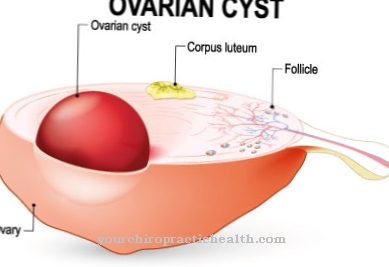The Retinopathia centralis serosa Ophthalmologists like to refer to it as a "manager's disease". The reason for this is that a lot of stress can trigger this visual disorder. A gray spot appears in the field of vision, objects are seen distorted and it is difficult to read and recognize the colors.
What is central serous retinopathy?

© Edward - stock.adobe.com
In the Retinopathia centralis serosa it is a disease of the retina. This causes fluid to escape from the choroid, lifting the retina locally from the pigment epithelial layer. This is known as retinal detachment due to swelling. It is pushed forward and closer towards the lens.
The unevenness that this creates lift the photoreceptors out of their conventional position. In rare cases, if the pigment layer is intact, the retina and the retinal pigment epithelium lift together. The disease predominantly affects men between the ages of 20 and 50, but it also occurs in women. The occurrence is often related to physical or mental stress.
causes
The exact cause of retinopathia centralis serosa, the retinal changes, is not known. However, stress has been mentioned as a cause of the disease for many years. Studies have shown that those affected often show pronounced competitive behavior, have a lot to organize and manage and are agile.
This is where the name “manager disease” is used. However, this does not mean that every stressed person will develop the eye condition. The reason for this is a different way of dealing with stress. The disease can also be associated with an increased concentration of the stress hormone cortisol.
Experts suspect that genetic susceptibility can also promote the occurrence of central serosa retinopathy. The same applies to an infection with Helicobacter pylori, a stomach germ. In this connection, too, the eye disease was partially observed. Ultimately, the clinical picture of retinopathia centralis serosa has not yet been adequately researched.
Symptoms, ailments & signs
With retinopathia centralis serosa, a gray-black hole appears in the field of vision. The view is clouded by a gray veil, objects appear distorted or doubled. These are all typical symptoms of eye disease, which often comes on quite suddenly.
In addition, due to the detachment of the retina from the choroid, there is often unilateral or bilateral farsightedness. Another sign of serosa central retinopathy is wave vision. The failure in the central field of vision is just as typical. This means that gray, black or blurred can be seen in a spot in the middle of the field of view.
Diagnosis & course of disease
If the retinopathia centralis serosa is suspected, an anamnesis and a careful examination by the ophthalmologist are necessary. The reason for this is that the changes in vision can also result from other diseases that are associated with similar symptoms. There are various options available to the doctor for a precise diagnosis, for example an eye test.
This is usually the hyperopia of the affected eye. Apparatus perimetry is also possible, for example threshold perimetry, which is used to determine and quantify the scotoma. On fundoscopy, ophthalmoscopy shows a visible edematous swelling of the retina.
The color sense test and spectral optical coherence tomography spectral optical coherence tomography (SOCT) are also used. Here, the detachment of the retina can be made directly visible, because a cross-sectional image is made with this recording technique. There are acute and chronic forms of central serosa retinopathy, which can occur on one or both sides.
In the acute form, the disease usually heals spontaneously within three to six months of onset. It is therefore customary to initiate therapy only after three months. A significant loss of vision only remains in isolated cases, but one or more recurring outbreaks of the disease can occur. If the retinopathia centralis serosa occurs repeatedly and leaves changes, it is called a chronic form. In this case, treatment should be started sooner.
Complications
Central serous retinopathy is rarely associated with complications. As a rule, spontaneous healing takes place. However, the disease itself occurs as a complication of a stress reaction in heavily stressed people. Since it often afflicts leaders, it is also commonly referred to as a manager's disease. Although the retina is partially lifted out of the choroid due to the penetrating fluid, blindness almost never occurs.
After several weeks or months, the disease heals without treatment and vision returns to normal. Sometimes, however, more severe gradients take place. Therapy should then be considered. In photothermal therapy, the retina is treated with heat. However, if the swelling is outside the macula, laser treatment should be carried out in the case of severe courses, since the photothermal therapy in this case leads to the destruction of the retina due to the development of heat.
After the symptoms have subsided, some patients have recurrences. To avoid such relapses, you should refrain from smoking and taking medication containing cortisone. The reduction of stress also promotes complete healing.
Mostly ambitious and impatient young men are affected, but they are so unsettled by the sudden visual disturbance that they may also need psychological support. As part of psychotherapy, it can be discussed how stress can be reduced in a specific case.
When should you go to the doctor?
Central serous retinopathy should always be treated by a doctor. This disease does not self-heal. If left untreated, the disease can lead to severe restrictions and discomfort in everyday life. A doctor should be consulted if the patient suffers from a disturbed field of vision. This can result in a black or gray point in the field of vision, so that the person concerned can no longer correctly see objects.
Furthermore, a sudden farsightedness indicates the retinopathia centralis serosa and must be examined if it occurs relatively suddenly and without a special reason. The visual field can also be accompanied by deficits, so that the person affected also suffers from disorders of sensitivity. Many patients can no longer correctly recognize colors due to retinopathia centralis serosa. If these symptoms arise, an ophthalmologist can be consulted. As a rule, central serous retinopathy can be treated well if it is discovered early.
Treatment & Therapy
In most cases of retinopathia centralis serosa, no therapy is required, as the disease usually resolves on its own. Those affected often recover from the visual disturbance within the next few months. All that is required is patience. Treatment should be initiated in the event of severe disease or repeated relapses.
In these cases, laser treatment, which is very common for this eye condition, can be considered. The leak in the choroid is obliterated with the laser. The prerequisite for this, however, is that there is an eccentric position with regard to the source point.
If everything goes well, the retina will stick to its subsurface again thanks to the laser light. This can lead to slight scarring, but this is not a problem. In some patients, however, repeated lifting of the retina causes large areas of scarring changes, so that vision is noticeably restricted. Even with spontaneous healing, there are some slight limitations in vision or visual quality.
Another method of treating central serous retinopathy is photodynamic therapy. Here, a light-sensitive drug is injected into the arm vein, which is distributed throughout the body within the next 15 minutes, which also applies to the vessels of the choroid. The drug is specifically activated by laser irradiation and the leaky blood vessel is closed.
You can find your medication here
➔ Medicines for visual disturbances and eye complaintsprevention
In order to avoid the occurrence of retinopathia centralis serosa, the stress load should be reduced. Relaxation methods such as Qi Gong and autogenic training are also helpful. This contributes to balance and an optimal work-life balance. It is always important to be aware of how stress affects the body. Sport is also helpful, because exercise strengthens the immune system and promotes the breakdown of stress hormones that are suspected of triggering central serous retinopathy.
Aftercare
In contrast to similar eye diseases, retinopathy does not lead to complete blindness. Retinopathia centralis serosa can heal on its own even without ophthalmological therapy. If the symptoms persist, targeted treatment should be considered. Symptoms can last a few weeks or months.
A visit to the ophthalmologist is nevertheless advisable, as the follow-up care should maintain the condition after the therapy. The medium to long-term goal is to avoid relapse, the patient should live permanently symptom-free. The treatment options are surgical or drug-based. The healing progress is checked during aftercare.
If an operation has been carried out on the eye, the well-known postoperative follow-up check takes effect. It ends with the discharge from the clinic.If the desired effect has been achieved with the appropriate medicine, the specialist stops the therapy and starts follow-up care. The condition of the eyes is checked at regular intervals even after an operation.
If the symptoms return, the treatment starts again. The patient can also contribute to the follow-up care by eating healthily and attending the check-up appointments. However, you should refrain from excessive alcohol and nicotine consumption. The complete renouncement of these luxury foods would be ideal.
You can do that yourself
Retinopathia centralis serosa often arises in connection with a stressful working day. It is therefore helpful when those affected reduce their exposure level. Physical relaxation and also mental exercises such as meditation can help reduce the vision problems. In any case, it is important to consult an ophthalmologist quickly if problems arise.
After the examination and the therapy recommendations, those affected can do something themselves to make everyday life easier. Breaks not only protect the eyes, but also the entire organism. With proper relaxation, the symptoms usually subside without medication. The doctor may also suggest a special therapeutic approach. This depends on the severity of the disease and the individual situation of the patient. In addition to a healthy lifestyle with nutrient-rich food and enough exercise, it helps to reduce stress and to avoid stimulants such as nicotine and alcohol.
Medicines containing cortisone are also considered to be triggers for the eye disease. In consultation with the doctor, you should consider whether it makes sense to stop certain medications for chronic diseases. This could support self-healing, but any other symptoms that may be present must also be taken into account.













.jpg)

.jpg)
.jpg)











.jpg)